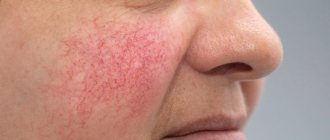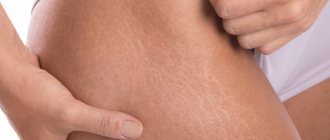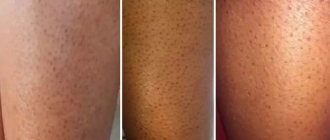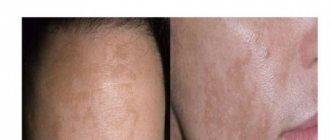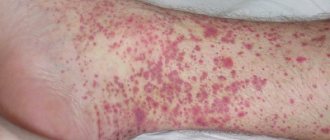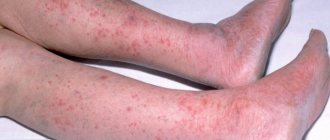Why do spider veins appear?
According to statistics, more than 50% of women and 10% of men have spider veins on their bodies. There are many reasons for their appearance:
- Heredity.
- Age-related changes.
The number of “stars” increases with age; - “Sedentary” or “standing” professions;
- Overweight;
- Injuries;
- Physical inactivity;
- Stress;
- Varicose veins;
- Congenital connective tissue diseases;
- Impaired blood microcirculation;
- Hormonal disorders (including when taking oral contraceptives and glucocorticoid drugs);
- Abortion, pregnancy and childbirth, menopause;
- Diseases of the reproductive system: ovarian cyst, uterine fibroids and others.
Spider veins can occur with a deficiency of vitamins and microelements, in particular with a deficiency of vitamin C, which is responsible for the permeability and strength of capillary walls.
Telangiectasias can appear after mechanical damage to the skin, for example during cosmetic cleansing. Often, vascular spots become visible after exposure to various types of radiation on the skin, for example, ultraviolet and x-rays. Some patients note their appearance after visiting a solarium.
The presence of spider veins on the legs is not necessarily associated with varicose veins: even varicose veins with severe symptoms of venous insufficiency sometimes occur without the appearance of telangiectasias, and the appearance of spider veins more often occurs against the background of mild venous insufficiency.
Why do spider veins appear on the legs?
Spider veins and spider veins on the legs are an expansion of small intradermal veins, as a result of which they become visible as “bluish veins.” The main reason for their appearance is hormonal status: female sex hormones help reduce the tone of the veins. Accordingly, in the overwhelming majority of cases they occur in the female part of our population. This may also explain their frequent occurrence during pregnancy. In addition, contributing factors include hereditary predisposition and prolonged static loads.
Why are varicose veins dangerous?
To this question, most of us will probably answer that spider veins are purely an aesthetic problem. Indeed, you no longer want to wear a short skirt or shorts with veined stars. However, this is not the main thing.
A network of small vessels that appears on the skin may indicate that you are developing varicose veins. In particular, you may already have dilated reticular veins - superficial vessels that have a diameter of about 2 mm and feed the spider vein. In addition, a fine network of red or blue vessels may indicate the presence of chronic venous insufficiency - a set of symptoms that indicates poor circulation in the veins.
How to get rid of spider veins on your legs?
Conservative treatment (especially wearing compression stockings) is quite effective in preventing the occurrence of spider veins. However, if they have already appeared, there are two main treatment methods:
- Sclerotherapy. Using an injection, a sclerosant is injected into the main feeding vessel - a substance that causes damage and gluing of the vessel walls. Within 1-2 weeks, the vessel and the vascular network it feeds become fibrotic and disappear. The method is very effective for larger vessels.
- Percutaneous laser coagulation. Typically a neodymium laser is used. It passes through the transparent upper layers of the skin and is absorbed by the hemoglobin in the blood. The vessel heats up and it is “soldered”. This method is more effective for smaller vessels.
Cuperosis - symptoms and treatment
Cuperosis is a skin disease that develops due to the fragility of capillary walls and local circulatory disorders. It is accompanied by a violation of skin color, loss of elasticity and the appearance of telangiectasia - spider veins or spider veins [1].
As a rule, rosacea is not an independent disease. This is a symptom that accompanies the underlying disease.
Vascular dilatation and fragility occur for a number of reasons. They can be both internal and external factors.
Internal factors:
- Rosacea is the main cause of rosacea;
- physiological hormonal changes - during adolescence, during pregnancy, menopause or when taking hormonal contraceptives;
- diseases of the ovaries, thyroid and pancreas;
- replacement therapy for endocrine pathology [5];
- cardiovascular diseases (arterial hypertension and atherosclerosis);
- diseases of the digestive system (gastritis, intestinal dysbiosis, liver and pancreas diseases);
- scleroderma and hereditary autoimmune diseases (Sturge-Weber disease, Louis-Bar syndrome, Randu-Osler disease).
In case of hormonal disorders, isolated particles of hormones interact with receptor cells, forming biologically active biological compounds. These compounds affect the walls of blood vessels, reducing their firmness and elasticity, making them brittle.
During pregnancy, serious hormonal changes occur in the body. The vessels may not withstand such a load and expand. Since this restructuring is temporary, the vessels are usually restored within 2-3 months after birth. But due to the development of other diseases (for example, hypertension), vasoconstriction after childbirth may not occur.
With hereditary autoimmune diseases, the amount of filamentous protein, which gives elasticity and elasticity to the vascular walls, decreases and the vessels become brittle. Scleroderma is accompanied by a rejection of connective tissue. This also affects blood vessels.
Rosacea affects the sebaceous glands, hair follicles and capillaries of the facial skin. Due to persistent dilation of blood vessels and a rush of blood, telangiectasias appear.
External factors:
- bad habits (smoking, alcohol abuse);
- unhealthy diet (drinking large amounts of coffee, chocolate, spicy and hot foods);
- temperature changes;
- ultraviolet irradiation.
Smoking affects blood vessels, destroying the balance of lipids in the blood. Lipids are fats that affect human metabolism. Destroyed particles from the lipid balance settle on the vascular walls, clogging their lumen. The heart, with an increased load, pushes blood through the vessels, as a result, different pressures are formed in the vessels with venous and arterial blood, which leads to an expansion of the capillary network.
Excessive alcohol consumption also contributes to the accumulation of fats in the vascular walls, and ethanol dilates the capillaries. It reduces blood pressure by relaxing the vascular walls, thereby losing the elasticity of the vessels and they remain dilated.
People with sensitive and fair skin are most susceptible to developing rosacea, especially under the influence of temperature changes and ultraviolet radiation. Such skin quickly reacts to external factors, which contributes to damage to the walls of blood vessels.
Which is better: sclerotherapy or laser coagulation?
These methods are not opposed, but rather complement each other. Larger vessels are better removed by sclerotherapy (it is easier to puncture them with a needle and inject the drug, there is less chance of rupture of the vein during injection, correctly administered sclerosant in the form of foam almost 100% leads to gluing of the vascular network). A small vascular network is difficult to treat with sclerotherapy due to technical reasons (the diameter of the vessels of the network can be comparable to the diameter of the needle). And for percutaneous laser coagulation, this is an advantage, since it is easier to heat and “seal” such a vessel with a laser without the possibility of burning the overlying skin. Thus, first, large vessels are removed using sclerotherapy, and then small ones are “reached” with a laser.
Prevention
To avoid having to carry out complex treatment of rosacea on the face, you must adhere to the following measures:
- Give up bad habits, switch to proper nutrition.
- The right way of life. Healthy sleep, moderate physical activity, avoiding stress - all this is very important.
- Proper skin care. It is best to consult a cosmetologist who will select care taking into account your characteristics.
- Regular skin protection from the sun. There is no need to be outside during periods of particularly sunny activity (from twelve in the afternoon to five in the evening), and it is also important to always use sunscreen.
- Protecting the skin from hypothermia - there are also special nourishing creams for winter.
Since the problem is related to the quality of the walls of blood vessels, a very important factor is proper nutrition. Once every year or two, for this reason, you need to visit a nutritionist-endocrinologist, take tests for missing substances and take a course of vitamins, and also adjust the menu in accordance with the doctor’s recommendations.
Is it possible to cure spider veins at home?
At home, you can and should prevent the appearance of spider veins. The most effective method is, of course, wearing compression hosiery (at least during pregnancy, on days of increased or prolonged static loads). Venotonic drugs have some effectiveness. A contrast shower, periodically throughout the day raising the legs above the level of the heart, and massage of the lower extremities (provided there are no varicose veins) will also be useful. However, it will not be possible to remove spider veins that have already appeared on the legs at home. This will require special procedures that can only be performed in a specialized clinic (sclerotherapy, percutaneous laser coagulation).
Be healthy!
Sign up for a free consultation with a phlebologist or ask any questions you have about phlebology and vein treatment by phone:
+7 (495) 255−50−11.
Features of the procedure
- Minor swelling, redness, and increased vascularity may persist for several hours after the procedure.
- The required number of treatment sessions is determined by the number and size of the affected veins, and the depth of their location in the skin.
- The interval between procedures is 4 - 5 weeks.
- Removal of small saphenous veins does not have a negative effect on the circulatory system. Healthy vessels located in the area of coagulated veins perform their functions compensatory.
Surgery is not scary
For the treatment of varicose veins the following are used:
- phlebectomy - surgical removal of varicose veins, when they are pulled out through a small incision in the skin,
- laser and radiofrequency surgery are also surgical treatment methods that, unlike traditional surgery, do not require incisions, are performed under local anesthesia and have no physical limitations.
Surgical methods for treating varicose veins and spider veins are the most effective today. Laser and radiofrequency treatments are more often used. They are less traumatic and do not require a rehabilitation process. After the operation, the patient is recommended to take a half-hour walk.
Why you shouldn’t be afraid of treating varicose veins with surgical methods, read more in the article “Varicose veins: should you be afraid of surgery to remove veins?”
What is the price? Cost of treatment
A very important issue is the cost of removing stars. Agree, it should be reasonable. In our practice, we use the most cost-effective minimally invasive technique - sclerotherapy. We differ from other clinics in that it is very important to us that you get the desired aesthetic result with minimal time and an affordable price.
Please note that our one-time, one-time payment includes the entire course of treatment and the necessary ultrasound control. Everything is included, regardless of the number of required visits, sclerotherapy sessions, procedures, follow-up visits and additional injections. We are not supporters of low prices for each treatment session (clinic visit). In some cases, many such sessions or visits may be required (5, 10 or even 15). In some medical centers, the final amount for a course of treatment can actually become very high and will unpleasantly surprise you.
Our main difference and advantage is kindness, attention, experience, competence and professionalism of the phlebologist Igor Vitalievich Elshansky.
In addition, with us you can always, at a time convenient for you, without a queue, by appointment, undergo a complete diagnosis of the condition of the vessels of the lower extremities (veins and arteries) with discounts on the promotion. Our medical center is equipped with modern diagnostic and treatment equipment.
What is a laser in the modern sense?
A laser is a device that creates a powerful stream of electromagnetic radiation with a certain wavelength. In other words, it is a beam of high intensity monochromatic light. The postulates that made it possible to create such a device were formulated by Albert Einstein at the beginning of the 20th century, and the first optical quantum generator (laser) producing waves in the optical range was created in 1960 by Theodore Maiman (USA).
Laser generator "CUTERA XEO"
I bought an expensive ointment - now everything will definitely pass
This is what many people think who have fallen victim to an advertisement where varicose veins miraculously disappear after a girl applies cream to her leg. To doubt the veracity of such a video, you need to know what “varicose veins” are.
Varicose veins are dilation of the veins of the lower extremities, which can only be radically cured by surgery. Ointments and tablets help, but not always as advertised. The benefits of drugs in the treatment of varicose veins depend on the stage of the disease.
In the first stages of the disease , when the patient complains of heaviness in the legs, pain, itching, and when spider veins appear, drugs against varicose veins will help relieve unpleasant symptoms and slow down the development of the disease.
At the stage of the appearance of varicose veins, ointments and tablets for varicose veins are ineffective, since they cannot in any way affect the improperly functioning veins. Such veins do not carry blood for purification, but return contaminated blood to the foot. Surgery will help get rid of them, and medications will speed up the healing process.
When edema appears , treatment for varicose veins becomes complex and includes medications, compression garments and surgery. Surgery is needed to remove dysfunctional veins, and underwear and medications contribute to recovery.
At stages with trophic and ulcerative skin changes, independent treatment is contraindicated. Ointments, gels and tablets will not help as long as the cause of the disease remains - that is, the affected veins. Treatment in the final stages of varicose veins is prescribed by the doctor individually for each patient. Self-administration of medications can worsen the condition.
Ointments and tablets for varicose veins are prescribed in combination with other treatment methods to improve valve function, blood circulation, and reduce the risk of thrombosis. Ointments and gels are effective in reducing discomfort and relieving heaviness in the legs, thanks to the cooling components in the composition.
Let's compare prices
The average price of drugs for varicose veins with heparin, escin and essential phospholipids in the composition is 1,000 rubles. With grape leaf extract - from 1,300 rubles. For a drug with an extract from the small intestinal mucosa you will pay more than 3,000 rubles. The price of the cheapest products is on average about 300 rubles per package. A tube of gel for varicose veins or a package of tablets is enough for about a month of use. Spending 1,000 rubles a month on drugs for varicose veins will cost 12,000 rubles in a year. However, the disease will not disappear anywhere. On the contrary, it will continue to develop at a slightly slower pace. In two years, varicose veins will enter a more complex stage and will require greater costs.
To avoid complications and not waste money, consult a phlebologist. The doctor will prescribe treatment and select an effective set of medications, based not on sensations, but on the knowledge and results of your examination.
History of the development of laser medicine
Vascular formations of various locations, being cosmetic defects, often cause psychological discomfort in both women and men. The first attempts to solve such problems using laser radiation were made in the late 60s and early 70s of the last century. An argon laser with continuous radiation was used. Despite its effectiveness, the abundance of undesirable reactions (scarring, permanent dispigmentation) significantly limited the use of this technique.
The formulation of the theory of selective photothermolysis by Harvard Medical School scientists Richard Anderson and John Parrish in 1983 changed the situation. This created a kind of revolution in laser medical technologies. The basis of this theory is the selective absorption of radiation with different wavelengths by different substances. That is, a light beam of a certain monochrome light will be absorbed by a chromatophore substance (the concentration of which in the target cell is much higher), impart energy to it and cause a corresponding effect, without affecting the surrounding tissues. Determining the appropriate wavelength, pulse duration and energy density allowed doctors to selectively target hemoglobin in blood vessels without damaging surrounding tissue. The result of this tactic was a sharp reduction in side effects, such as hypo- and hyperpigmentation, and an almost complete absence of scarring.
Microfoam sclerotherapy
Another effective way to combat asterisks is microfoam sclerotherapy, which promotes the complete disappearance of diseased vessels.
It consists of introducing a special drug (sclerosant) into the vessel, which, by filling the vessel, promotes its “gluing”. Gradually the vessel disappears, turning into connective tissue. The treatment does not require special preparation and is not accompanied by rehabilitation, except for the need to wear compression stockings for 5 days. Along with the removal of the mesh, the doctor, based on the diagnostic conclusion, will prescribe treatment that will promote a deeper solution to the problem. Here everyone is treated with due attention, and the professionalism of the medical staff contributes to success in getting rid of the most difficult problems in the field of phlebology.
All reviews
Treatment of spider veins:
- sclerotherapy
- laser
- electrocoagulation
- ozone therapy
Different clinics use different options. In some cases, a classic operation may be required - surgical removal of an incompetent vein. The choice of the most preferred method is individual. It is carried out with a focus on your wishes and at the same time, clinical feasibility and effectiveness are necessarily taken into account. The final optimal decision can only be made by an experienced, good phlebologist . Based on our 25 years of experience, sclerotherapy is the most effective, safe and comfortable technique. It allows you to achieve impressive, long-lasting cosmetic results.
Methods for diagnosing the disease
The diagnosis is made by a phlebologist. He examines the patient lying and standing. The doctor needs to distinguish reticular varicose veins from telangiectasia, the initial stage of livedo reticularis, Klippel-Trenaunay syndrome, Maffucci syndrome, Bloom's syndrome, and port wine stain.
Ultrasound in duplex mode is prescribed. Using ultrasound, the condition of the vein valves is assessed. The diagnosis is established if a violation of the reticular blood flow is confirmed, i.e., there is obstruction and reflux of the superficial vessels.
An ultrasound scan is performed. Dopplerography shows the direction of blood movement. During the scan, the doctor asks you to hold your breath, strain, and simulate walking while lying down. An image of green and red vessels is displayed on the screen. The red color shows the extent of the pathological area, and the green color shows the functionality of the venous valve. The direction and speed of blood movement is indicated.


